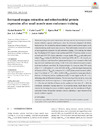Identificador persistente para citar o vincular este elemento:
https://accedacris.ulpgc.es/jspui/handle/10553/75553
| Título: | Increased oxygen extraction and mitochondrial protein expression after small muscle mass endurance training | Autores/as: | Skattebo, Øyvind Capelli, Carlo Rud, Bjarne Auensen, Marius Calbet, Jose A.L. Hallén, Jostein |
Clasificación UNESCO: | 241106 Fisiología del ejercicio | Palabras clave: | Arteriovenous Oxygen Difference Blood Flow Endurance Training Fick Method Limitations, et al. |
Fecha de publicación: | 2020 | Publicación seriada: | Scandinavian Journal of Medicine and Science in Sports | Resumen: | When exercising with a small muscle mass, the mass-specific O2 delivery exceeds the muscle oxidative capacity resulting in a lower O2 extraction compared with whole-body exercise. We elevated the muscle oxidative capacity and tested its impact on O2 extraction during small muscle mass exercise. Nine individuals conducted six weeks of one-legged knee extension (1L-KE) endurance training. After training, the trained leg (TL) displayed 45% higher citrate synthase and COX-IV protein content in vastus lateralis and 15%-22% higher pulmonary oxygen uptake ((Formula presented.)) and peak power output ((Formula presented.)) during 1L-KE than the control leg (CON; all P <.05). Leg O2 extraction (catheters) and blood flow (ultrasound Doppler) were measured while both legs exercised simultaneously during 2L-KE at the same submaximal power outputs (real-time feedback-controlled). TL displayed higher O2 extraction than CON (main effect: 1.7 ± 1.6% points; P =.010; 40%-83% of (Formula presented.)) with the largest between-leg difference at 83% of (Formula presented.) (O2 extraction: 3.2 ± 2.2% points; arteriovenous O2 difference: 7.1 ± 4.8 mL· L−1; P <.001). At 83% of (Formula presented.), muscle O2 conductance (DMO2; Fick law of diffusion) and the equilibration index Y were higher in TL (P <.01), indicating reduced diffusion limitations. The between-leg difference in O2 extraction correlated with the between-leg ratio of citrate synthase and COX-IV (r =.72-.73; P =.03), but not with the difference in the capillary-to-fiber ratio (P =.965). In conclusion, endurance training improves O2 extraction during small muscle mass exercise by elevating the muscle oxidative capacity and the recruitment of DMO2, especially evident during high-intensity exercise exploiting a larger fraction of the muscle oxidative capacity. | URI: | https://accedacris.ulpgc.es/handle/10553/75553 | ISSN: | 0905-7188 | DOI: | 10.1111/sms.13707 | Fuente: | Scandinavian Journal of Medicine and Science in Sports[ISSN 0905-7188], v. 30(9), p. 1615-1631, (Septiembre 2020) |
| Colección: | Artículos |
Citas SCOPUSTM
21
actualizado el 08-jun-2025
Citas de WEB OF SCIENCETM
Citations
22
actualizado el 08-jun-2025
Visitas
89
actualizado el 18-feb-2024
Descargas
372
actualizado el 18-feb-2024
Google ScholarTM
Verifica
Altmetric
Comparte
Exporta metadatos
Los elementos en ULPGC accedaCRIS están protegidos por derechos de autor con todos los derechos reservados, a menos que se indique lo contrario.
